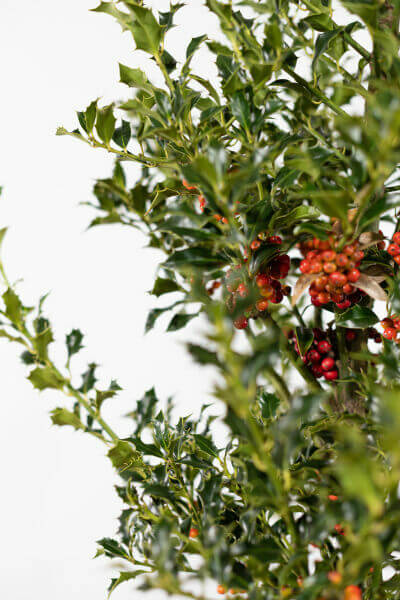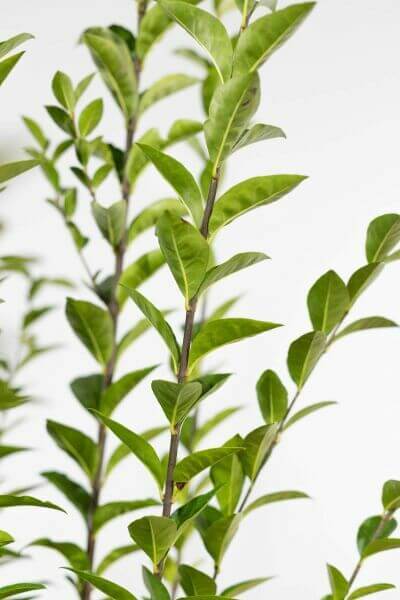Hedge Plants For Edible Hedges
Enhance your garden's attraction with lush hedge ranges such as Yew (Taxus), Thuja, Laurel, Photinia, and Bamboo, commemorated for their structural integrity and ecological benefits.
Yew and Thuja offer evergreen protection and winter strength, while Laurel provides quick growth and broad, aromatic leaves.
Photinia adds seasonal appeal with its lively red foliage, and Bamboo lends a low-maintenance, tranquil atmosphere.
These hedges improve air quality, minimize noise, and produce tranquil, personal areas.
Appropriate planting, spacing, and upkeep ensure vigorous development and ecological harmony.
Check out how these lavish varieties can raise your garden's beauty and well-being.
Key Takeaways
Change Your Garden With Lush Hedge Ranges
- Select Yew for its dense, evergreen growth and exceptional longevity.
- Choose Laurel for its fast development and broad leaves, making sure fast privacy.
- Choose Photinia for its dynamic seasonal foliage, which turns a striking dark red.
- Use Bamboo for a low-maintenance, winter-hardy hedge with visual appeal.
- Area plants 2-3 per meter and prune frequently for optimum development and health.
Popular Hedge Plants
When changing a garden with lavish hedge ranges, it's essential to consider popular hedge plants such as Yew, Thuja, Laurel, and Photinia due to their special attributes and benefits.
Yew (Taxus) is highly esteemed for its longevity and thick, green development, making it a prime option for sustaining landscapes.
Thuja is kept in mind for its evergreen foliage and robust winter strength.
Photinia includes seasonal vibrancy with red leaves that darken over time, creating dynamic visual appeal.
Laurel offers quick development and aromatic, broad leaves, suitable for quick privacy.
Additionally, Bamboo is an excellent option for atmosphere, providing a low-maintenance, winter-hardy choice that enhances the garden's aesthetic with its elegant, swaying canes.
These choices accommodate a variety of horticultural requirements and choices.
Benefits of Garden Hedges
Garden hedges use a plethora of advantages, making them an important addition to any landscape. These natural barriers are affordable to execute and provide considerable wind protection, boosting air flow and contributing to sound reduction. The thick foliage of hedges like Thuja and Beech guarantees personal privacy by obstructing presence, producing a serene and remote environment.
Hedges also play an important role in microclimate policy, providing a stable environment that cultivates plant growth and decreases temperature changes. Their intricate leaf structures filter contaminants, enhancing air quality and contributing to a healthier garden environment.
Moreover, hedges master sound decrease, absorbing and deflecting sound waves to lower ambient sound levels. This double functionality of providing both acoustic and visual personal privacy enhances the general harmony and visual appeal of any garden.
Planting and Maintenance Tips
For a successful hedge, meticulous preparation of the planting area is important. Make sure the soil has correct pH and drainage to support strong root development.
Space the plants appropriately for the selected species. Water the hedge often throughout its preliminary development stage, changing as required with seasonal modifications.
Execute a methodical insect control and illness avoidance technique, utilizing chemical or organic treatments when essential. Regularly inspect for aphids, mites, and fungal infections.
Apply mulch to retain moisture and suppress weeds. Seasonal pruning promotes thick development and air blood circulation, vital for plant health.
Following these standards will help you cultivate a dynamic, properly maintained hedge that enhances the beauty of your garden.
Spacing and Trimming Guidelines
Spacing and Cutting Standards
Correct spacing and cutting are vital for cultivating healthy, aesthetically appealing hedges. Appropriate spacing makes sure each plant gets enough nutrients, light, and air flow.
Follow these standards for optimum hedge upkeep:
- Spacing: Position hedge plants 2-3 plants per meter to motivate robust development.
- Pruning Methods: Regular pruning is important for preserving desired hedge height and shape. Trim new development in summer season and cut down older wood throughout winter.
- Seasonal Care: Adjust trimming methods and schedules according to seasonal requirements to make sure plant health.
- Hedge Height: Frequently screen and trim to maintain the desired hedge height and attain consistent aesthetic appeals.
Complying with these actions will ensure your hedge flourishes, enhancing both the appeal and performance of your garden.
Selecting the Right Hedge
Choosing the Right Hedge
Picking the proper hedge involves website evaluating aspects such as mature height, foliage density, and environmental strength. Successful hedge plant choice needs understanding each types' growth attributes and site-specific versatility.
For example, Yew (Taxus) uses outstanding durability and dense development, while Thuja is noteworthy for its winter durability. Additionally, thinking about maintenance requirements is important; fast-growing species like Laurel or Privet need regular cutting, whereas low-maintenance options like Bamboo or Ivy may be preferable for those looking for minimal upkeep.
Ecological elements such as soil type, light schedule, and moisture conditions must also direct the choice process. This cautious approach guarantees the picked hedges will thrive, offering both aesthetic and functional benefits to the garden landscape.
Delivery and Planting Suggestions
To ensure your hedge plants flourish, they need to be delivered by specialized couriers and planted immediately upon arrival.
Follow these essential steps for successful planting:
- Soil Preparation: Improve the soil with raw material to improve drainage and nutrient content.
- Planting Depth: Produce a trench two times the width and equal to the depth of the root ball.
- Watering Techniques: Water thoroughly after planting, keeping the soil regularly wet however not filled.
- Mulching: Apply a layer of mulch to retain moisture and suppress weeds.
Client Assistance and Service
Offered the vital function of timely help in horticultural pursuits, our customer support team is offered 6 days a week through telephone, e-mail, and social networks to use skilled advice and swiftly address any concerns. Their dedication to quick response times ensures customer satisfaction by resolving queries related to plant health, optimal planting approaches, and upkeep schedules.

-------------------
6 days a week
This extensive support group, reinforced by a stellar 9.3/ 10 consumer ranking, highlights our commitment to enhancing the gardening experience for every customer.
Often Asked Questions
The Length Of Time Does It Consider Hedge Plants to Establish?
Hedge plants usually require one to 3 years to become totally established, with the specific duration differing by species and growing conditions.
Efficient care throughout this crucial duration is important for robust development. Consistent watering, watchful weed control, and proper fertilizer application are pivotal in promoting strong root advancement.
For instance, fast-growing species like Laurel may develop more quickly, while slower-growing varieties such as Yew may take longer. Diligent maintenance speeds up the facility procedure, resulting in dense and healthy hedges.
What Are the Finest Hedge Plants for Privacy?
The question of the finest hedge plants for personal privacy includes evaluating evergreen and deciduous choices.
Evergreen hedges like Thuja, Laurel, and Cypress supply year-round protection, ensuring continuous privacy.
In contrast, deciduous hedges such as Beech provide seasonal personal privacy, shedding leaves in cooler months.
Secret upkeep tips for privacy hedges include regular trimming, fertilizing in spring, and proper spacing-- generally 2 to 3 plants per meter.
Furthermore, constant watering and persistent weed removal are important for promoting healthy, dense growth.
Can Hedge Plants Attract Wildlife to My Garden?
Yes, hedge plants can attract wildlife to your garden by providing important benefits like shelter, food, and nesting sites, thereby boosting regional biodiversity. Yew, holly, and laurel are excellent for attracting birds, while ivy supports a range of bugs.
However, it is essential to keep in mind that there are some downsides, such as increased upkeep to manage bugs and routine upkeep. Thoroughly choosing and preserving hedge varieties can assist balance these benefits and downsides, eventually fostering a vibrant and sustainable community in your garden.
Are There Any Blooming Hedge Plants Available?
Yes, there are flowering hedge plants offered that can enhance the beauty of your garden.
For instance, Elaeagnus, also known as Olive Willow, produces aromatic white flowers in the fall, adding a touch of sophistication.
Photinia, another popular choice, showcases lively red leaves that mature into an abundant green, producing a dynamic visual result throughout the seasons.
To ensure these plants grow, it's important to practice proper pruning methods and seasonal upkeep, such as trimming brand-new growth in the summer season and cutting back in the winter season.
These measures will help keep the health and aesthetic appeal of your blooming hedges.
How Do I Avoid Pests in My Hedge Plants?
To prevent bugs in hedge plants, use natural pest control approaches and maintain proper hedge care. Present helpful insects like ladybugs, which take advantage of damaging pests, to produce a well balanced environment.
Regularly inspect your hedges for indications of problem and promptly eliminate any affected parts to avoid the spread. Guarantee the health of your hedges by using well balanced fertilizers and supplying adequate water.
Use mulching to keep soil wetness and appropriate spacing to lower plant tension and promote robust development. These practices jointly assist in decreasing pest issues and maintaining a healthy hedge.
Conclusion
In essence, choosing the ideal hedge ranges such as Yew, Thuja, and Laurel can change any garden into a serene sanctuary. These plants offer year-round greenery, enhance aesthetic appeal, and deal useful advantages like noise reduction and wind protection.
Correct planting strategies, precise spacing, consistent watering, and seasonal trimming are vital for optimum development.
Trustworthy delivery services and expert consumer assistance guarantee a seamless experience from purchase to planting, making it easier than ever to elevate your outdoor area.
Garden hedges provide a wide range of benefits, making them an important addition to any landscape. These natural barriers are economical to implement and supply considerable wind protection, boosting air flow and contributing to noise decrease. The dense foliage of hedges like Thuja and Beech guarantees privacy by blocking visibility, developing a serene and remote environment.

Pruning Strategies: Routine pruning is necessary for keeping wanted hedge height and shape. Cut new growth in summer and cut back older wood throughout winter season.